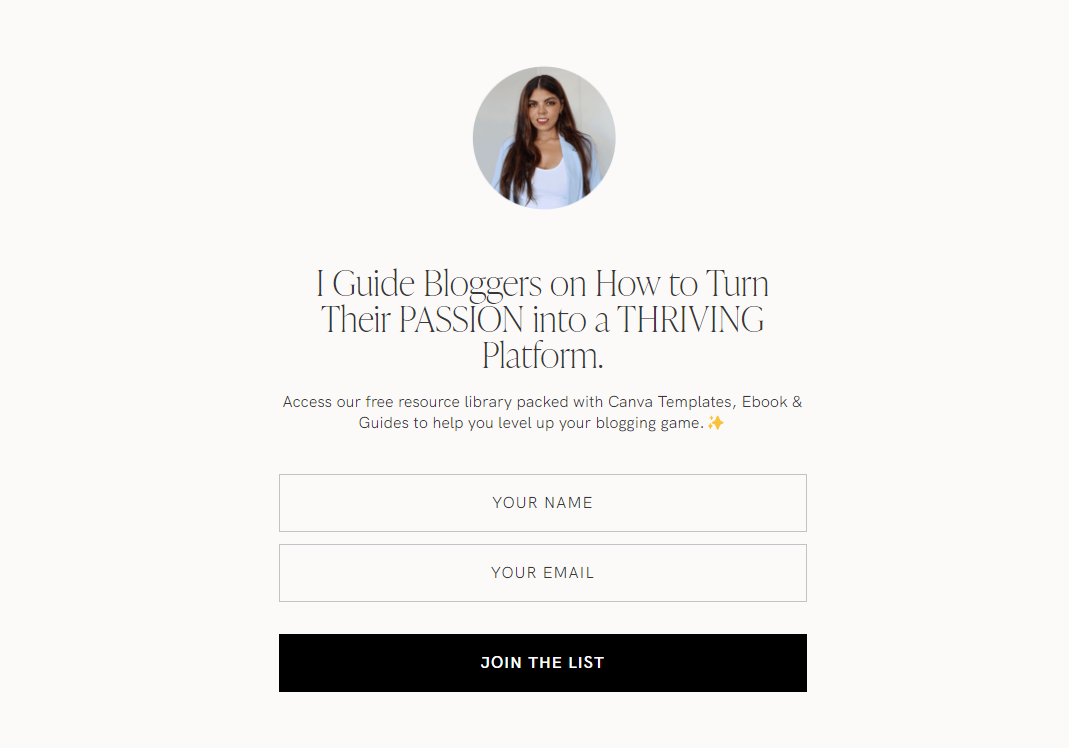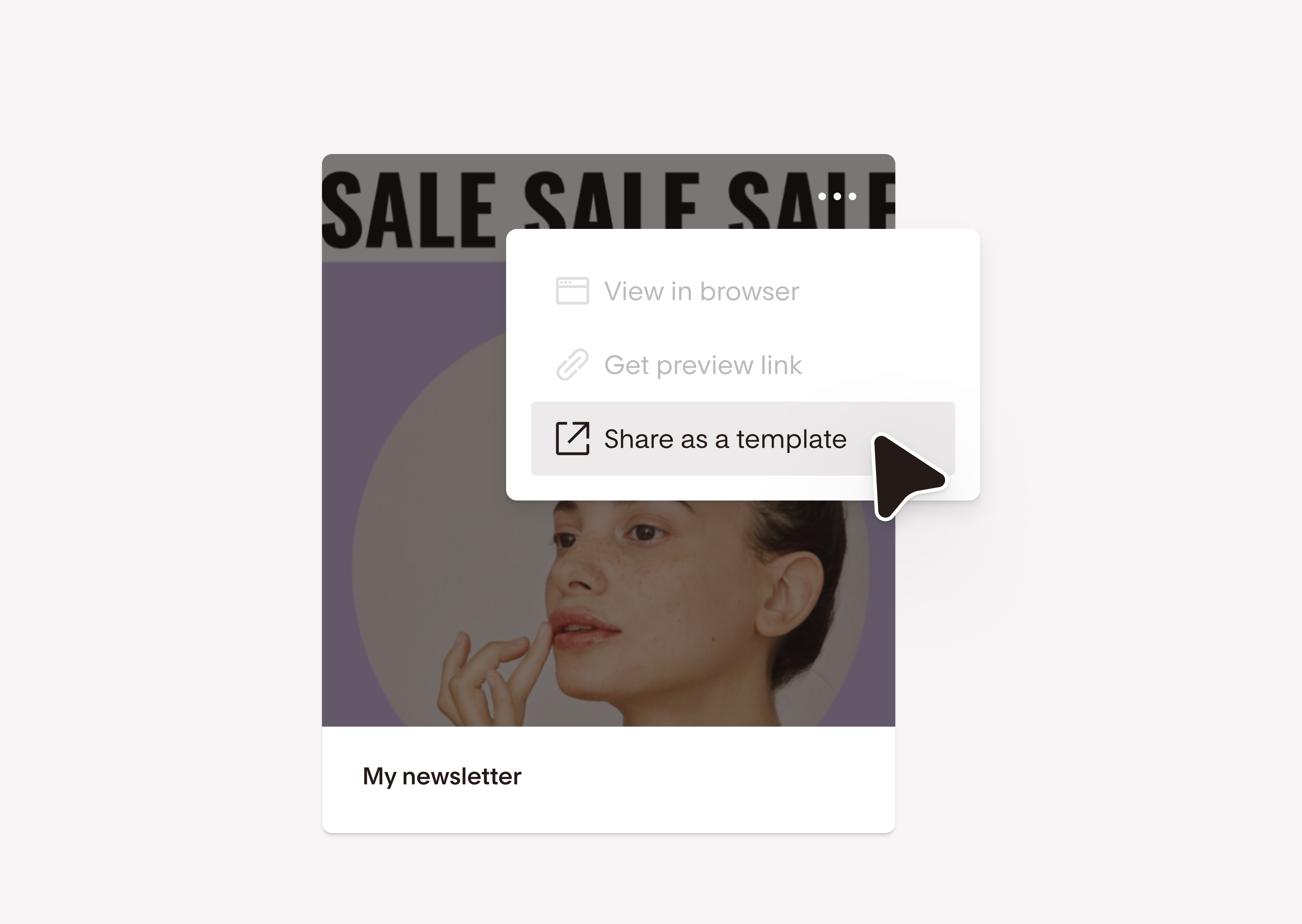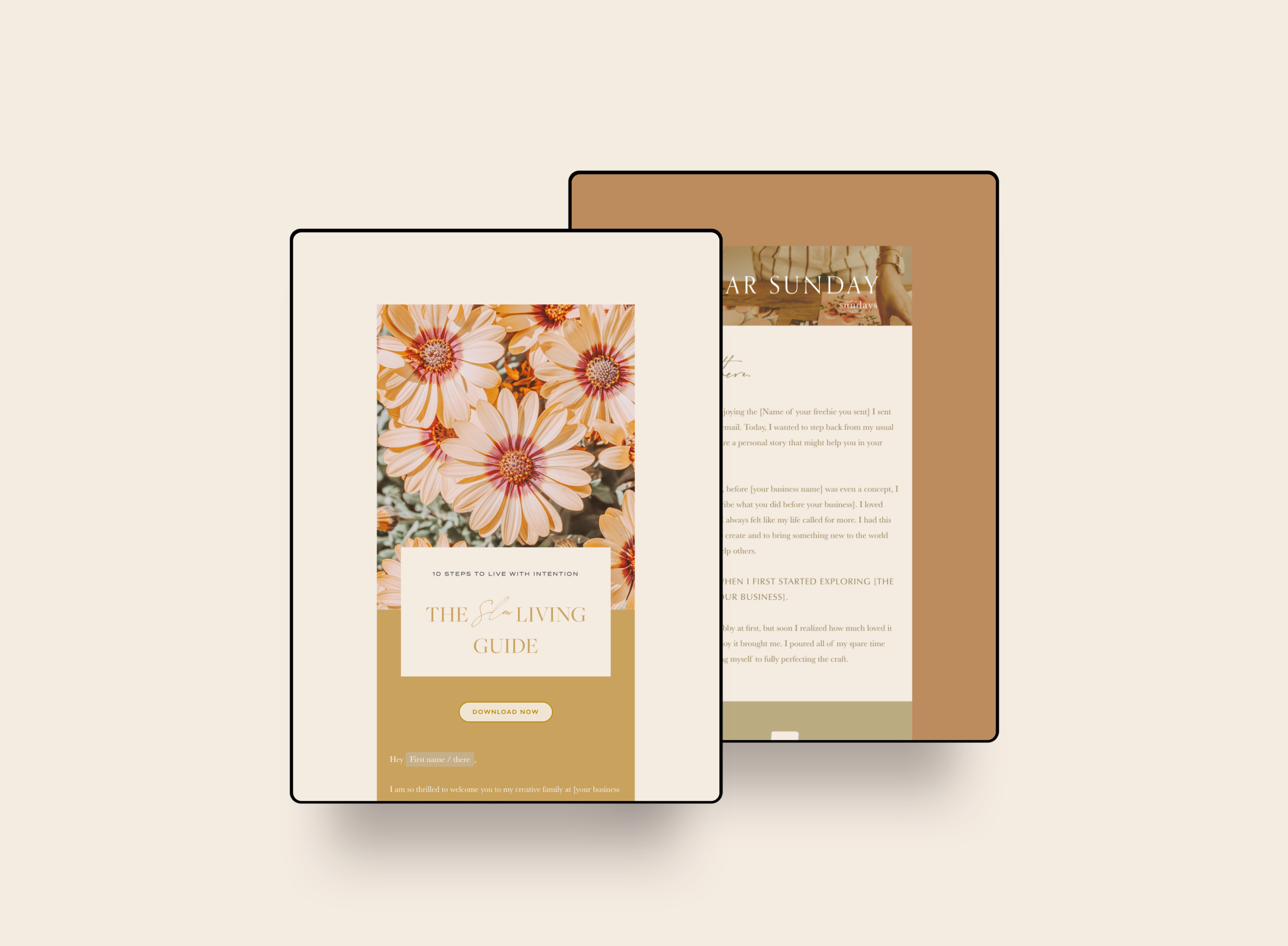How to make money selling Canva templates
Table of Contents Jump to:
Jump to:
Table of contents
TL;DR: Making a steady income by selling Canva templates isn’t as hard as you might think. We’ll explore Canva template designs you can create, where and how you can sell them, and how much money you can earn selling Canva designs.
You can use Canva for just about anything nowadays—to put together presentations, create business proposals, design social media posts, make event invitations, and even generate marketing materials. But did you know producing and selling your own Canva templates can be a great way to build your passive income and expand the digital products you offer?
If you’re wondering how to sell Canva templates, you’ve come to the right place. We’ll discuss how much money you can make, potential expenses, which templates you can create, where to sell your designs, and how you can get started.
Sell your Canva designs or templates with Flodesk
Use Flodesk Checkout and Flodesk Email to sell and deliver your beautifully designed Canva templates to create a seamless buyer experience.
Why you should design Canva templates to sell
There are three main reasons why selling Canva templates is worthwhile:
- It can be a great source of income, whether you want to make a little extra money on the side or turn it into a full-time job.
- It lets you hone your design skills and share your creativity with a wider audience.
- You may end up expanding your business in ways you would’ve never thought of before. Lots of content creators and entrepreneurs start by making a one-off Canva template, which turns into a much bigger and more exciting project over time.
It’s also worth mentioning that even though there are already many Canva templates out there (including those the platform designs and shares itself), the demand for these digital downloads is still incredibly high.
The most important thing to keep in mind if you want to successfully sell Canva templates is to design unique products that aren’t widely available on the market and solve a problem or serve a need for a specific customer niche.
How much can you make selling templates?
Selling Canva templates can certainly be lucrative, especially if you tap into the right market, niche, or customer needs, and create designs that the masses want to buy.
To give you an idea of the profit potential, Canva templates typically sell for between $12–$16 on common online marketplaces. That means if you sold 500 templates, you could make between $6,000 and $8,000.
It can be tricky to price digital downloads. So be sure to take a look at what other sellers are charging for their Canva templates and keep track of how much you need to ask for to keep your business running profitably.
Costs of a Canva template business
One of the reasons why selling Canva templates is so popular is because it’s inexpensive. Most people can afford the tools required to start designing Canva templates and it comes with very low recurring expenses. But there are a few costs to consider:
- Your Canva account. This can range between free and $119.99 per year per person depending on whether you sign up for a Free or Pro account.
- Licensing fees. Depending on the Canva design elements you include in your templates (as well as the commercial objectives you have for your Canva templates), you may have to pay Canva for a special distribution license. Be sure to consult their Terms of Use and their Content Licensing Agreement for more information.
- Platform or website fees. You’ll likely have to pay a little bit to sell your templates, but the exact charge depends on where you do so. For example, you won’t have to give up any percentage of your sales if you sell your Canva templates on your website. But, you will have to pay for your upkeep and domain. And if you want to sell your Canva templates on a platform like Etsy or Creative Market, you’ll have to pay a monthly fee.
- Other design tools. Some designers may want to use additional design tools like Photoshop or Figma to create more sophisticated marketing and product images to promote their templates. If that’s you, it’s worth remembering that all those tools come with additional one-off or monthly costs.
Canva templates you can create
The Canva templates you can create are limitless. The more creative yours are, the better. Check out some of the most popular kinds of Canva templates people sell to help you brainstorm ideas:
- Social media graphics, posts, banners, thumbnails, and platform-specific visuals (like templates for Instagram stories or story highlight covers)
- Website or blog graphics, logos, featured images, headers, hero sections, layouts, backgrounds, and footers
- Email templates
- Workbooks, worksheets, or ebooks
- Calendars or planners
- Presentations, infographics, whiteboards, graphs, charts, and other digital assets
- Event invitations, graphics, and menus
- Greeting cards, gift tags, and seasonal place-setting cards
- Brochures, posters, signs, flyers, and business cards
- Resumes, CVs, cover letters, and letterheads
- Stickers
Useful insights: Learn how to sell on Instagram
Where to sell your Canva templates
You can sell Canva templates nearly anywhere, but here are a few of the more common ways seasoned designers and content creators are doing it.
Etsy
Etsy is a well-known online marketplace that connects buyers and sellers all around the world. People most often use it to sell handmade items, but many Etsy users sell digital products successfully on the platform.
Many people use a platform like Etsy when they’re just getting started creating Canva templates but don’t have a dedicated website or landing page set up.
You can sign up for an Etsy account for free if you want to sell your templates on the platform. It’s a popular platform, complete with a steady stream of customers that’ll browse through your offerings.
There are some fees associated with selling on Etsy:
- $0.20 listing fee (per product)
- 6.5% transaction fee
- Payment processing fees that change based on bank account location
Etsy users also have the option to sign up for Etsy Plus, which costs $10/month but comes with benefits like storefront customization, restock requests, listing credits, ad credits, and other discounts.
Creative Market
Creative Market is another online marketplace, specializing in design assets and digital products. Along with templates, Creative Market users sell things like graphics, fonts, photos, and web themes.
Creative Market requires members to pay monthly subscription fees that include a set amount of digital download credits. This means you’ll always have a captive audience browsing through your products.
Even though it doesn’t cost anything to set up a shop on Creative Market, they take a hefty 50% commission from all the sales you make.
Your website
Selling Canva templates on your website can be one of the most lucrative options. That’s because you don’t have to pay a monthly fee or give up a percentage of your sales to a marketplace platform. You’ll also have greater flexibility to design your website exactly the way you want. However, this option isn’t as beginner-friendly because:
- You need to either build a website yourself or hire someone to do it for you
- You need to maintain your website or hire someone to do it for you
- You most likely won’t have a large number of people browsing your website when you’re just starting out. So, it’ll be harder to connect with buyers and market yourself
You can build your website with a content management system (CMS) like WordPress or a beginner-friendly platform like Squarespace or Weebly.
A unique landing page
Another way to sell templates without giving up a percentage of your sales is by building dedicated landing or sales pages. That way, you can target your known audience, direct visitors to your page, and start making money selling Canva templates.
If you use a platform like Flodesk Checkout to promote your templates, the process could look something like this:
- Use one of our stunning templates to create a sales page that stands out and catches people’s attention while sharing information about your Canva templates
- Build a checkout page so people can buy your Canva templates and get their payments processed quickly and intuitively
- Put together a delivery page that will give buyers instant access to a digital download or links to other post-sale actions
Read next: How to sell on Pinterest
Your Link in bio
Think of your link in bio as a digital storefront for your brand, where you can showcase and sell your Canva templates right from your social media profiles. Potential customers can click the link in your bio and open the doorway to your visual gallery. Once inside, they’ll find a landing page packed with personalized links to your finest Canva creations.
Design appeal and intentional messaging are key once customers are browsing your link list. Candice of The Blog Social uses her Flodesk Link in bio to direct her followers to a beautifully designed signup form, where she sells a variety of free and paid Canva templates. All elements, including the custom font, images, button design, and explainer copy, perfectly represent her brand.
The magic doesn’t stop there with a Link in bio. Create a lasting connection with your audience by:
- Driving newsletter signups: Create a signup form to prompt followers to subscribe to your newsletter
- Directing visitors to your website: Include a link to visit your website, where followers can continue discovering your offerings
- Adding valuable offers: Promise a sneak peek of your upcoming designs or share exclusive discounts for those who subscribe
As your social followers click through your Link in bio, use clear CTAs to direct them toward purchasing your Canva templates. Regularly analyze performance metrics to understand how people interact with your Link in bio, then refine your approach to enhance the overall customer experience.
Turn followers into subscribers with a Flodesk Link in bio
Capture followers’ emails right from your social profiles to grow your list.
How to sell your Canva templates in six steps
Selling your Canva templates doesn’t have to be complicated—just follow these six steps and you’ll have your process set up in no time. Bonus: The more Canva templates you sell, the easier it’ll be.
1. Sign up for a Canva account
First, register for your Canva account if you don’t have one already. You’ll have to decide whether you want to opt for Canva Free or their Canva Proplan, which starts at $14.99 per person per month, or $119.99 for the year.
2. Create your Canva templates
The most important part of the process is actually designing the Canva templates. These are the digital products people will buy, and their novelty and quality are huge factors in how much you’ll be able to charge and how successful you’ll ultimately be.
If you need help getting started, browse through some of the following platforms for template inspiration:
- Behance
- Canva
- Creative Market
- Dribble
- Etsy
- 99Designs
However, a word of caution. There’s a fine line between getting inspiration from other artists, content creators, and graphic designers and plagiarizing. Make sure you don’t copy anyone’s templates. Not only is it unethical, but it’s also a bad business decision (template rip-offs do not sell well).
It’s also worth thinking about whether you’ll use Canva Free or Canva Pro elements to design your templates. If you use their Pro design elements, your customers may need Pro accounts to access your full templates and you could run into more complicated licensing issues. Creating your own elements is best.
3. Get your deliverables ready
Your deliverables are what people receive when they buy one (or a few) of your Canva templates.
Once you’re finished designing your Canva templates, you’ll need to get them into a format you can send out to your customers.
First, create a shareable template link by clicking on Share and then Template link.
Next, decide on an elegant way to send your template link to your customers. Some template sellers embed their links into branded PDF documents that they deliver to their buyers. Others include the links on thank you pages from sales funnel builder platforms like Flodesk Checkout.
Learn more: Ready to start selling your templates? Read up on the various e-commerce email templates to include in your sales sequences.
4. Develop your marketing content
Seasoned Canva template sellers will tell you to create at least a few product images of your templates so potential buyers can get a better look before they decide to buy them. This is a great way to show your customers more details about your templates and demonstrate what sets them apart.
5. Publish your Canva templates to your platform of choice
You might publish, share, and sell your Canva templates on one (or more) of the following platforms:
- Etsy
- Creative Market
- Your own website
- A unique landing page
Whatever option you decide to go with, it’s time to upload your new templates to that space. Then, you’ll be able to share them with your customers and start making some sales!
6. Promote yourself
Templates won’t sell themselves. You can’t simply publish your Canva templates onto your website or another creative marketplace and expect your ideal customer to stumble upon them by chance.
On the contrary, getting really good at promoting yourself and your work is a key aspect of running a successful Canva template business, whether you want it to be a side hustle or a full-time job. Here are a few ideas to help you spread the word about your newly published Canva templates:
- Share social media posts: Build an audience on social media platforms like Instagram or TikTok, and share stories, reels, and feed posts when you have new designs to share.
- Leverage your Link in bio: Effortlessly promote your Canva templates on your social profiles, like Instagram. Craft an engaging and visually appealing landing page that showcases a curated selection of your templates, using clear CTAs to drive potential customers to your sales platform. At the same time, encourage opt-ins to your newsletter for exclusive updates and offers—creating a community of interested buyers for future promotions and sustained monetization.
- Send a quick message to your subscriber list: Social media channels can be busy and competitive these days. It’s all too easy for promotional posts to get lost in the mix. Email marketing content has much higher engagement rates, so sending out a brief, visual newsletter to your email list is a great idea when you have fresh and creative templates to sell. You can also send abandoned cart emails to those who have checked out your templates but have not bought them.
- Collaborate with other creatives: There’s room for everyone at the top! Don’t be afraid to reach out to fellow content creators, entrepreneurs, and designers in your niche and ask if they’d be up for some cross-promotion. You’ll both get to dip into a new market, expand your reach, and make a great connection in your industry.
16 niche Canva template types you can sell
Let’s explore some real-world examples of the types of Canva templates you can create for various niches. The demand for stunning, easy-to-use templates is high for these categories, giving you some inspiration on what to design.
- Social media templates: Simplify the way people do social media marketing by creating social media templates to cover everything from engaging posts and carousel layouts to captivating stories and eye-catching covers. Design for platforms like Instagram, Facebook, X, and Pinterest.
- E-commerce and marketing: Help brands elevate their visibility by offering templates for beautiful product catalogs, engaging mockup designs, compelling marketing materials, eye-catching email newsletters, or attention-grabbing advertising banners.
- Personal branding and resumes: Empower your customers to craft a strong personal brand with Canva templates tailored for professional growth. Develop personal branding kits, impactful resumes, compelling cover letters, and standout LinkedIn profiles.
- Events and weddings: Design templates for elegant invitations, charming save-the-date cards, beautifully organized event programs, and exquisite wedding stationery that adds a touch of sophistication to every celebration.
- Health and fitness: Support individuals on their health and fitness journey. Design Canva templates for informative workout plans, practical meal planners, efficient fitness trackers, and personalized wellness journals.
- Education and e-learning: Elevate the educational journey for both educators and learners by selling Canva templates for lesson plans, engaging worksheets, professionally crafted certificates, and visually appealing course materials.
- Food and recipes: Create charming recipe cards, enticing menu templates, visually appealing food blog graphics, and informative cooking guides that bring culinary creativity to life.
- Travel and tourism: Make trip planning and exploration an easy experience by designing stylish itinerary templates, beautiful destination guides, inspiring travel journals, and efficient vacation planners.
- Business and corporate: Design templates for business presentations, reports, business cards, letterheads, logos, and other essential corporate materials. Let your customers create a cohesive and polished visual identity that speaks volumes for their brand.
- Real estate: Create Canva templates for property listings, real estate brochures, and professional rental agreements. You’ll help agents showcase their listings, and streamline the communication and transaction process with their clients.
- Healthcare and medical: Healthcare professionals need templates too. Create templates for clear and concise educational charts, informative healthcare brochures, practical patient appointment cards, and comprehensive wellness checklists—so they can deliver a seamless experience to their patients.
- Photography and portfolio: Showcase your visual artistry by selling Canva templates for portfolios, photography contracts, photo watermarks, and photo album layouts.
- Arts and crafts: Allow artists and craftspeople to infuse creativity in their prints, crafts, and creative workshops with your templates. Ideas are templates to showcase work, guide a craft activity, or organize a creative event.
- Greeting cards and invitations: Craft personalized templates for birthday celebrations, heartfelt holiday greetings, expressive thank-you notes, and charming event invitations, ensuring each sentiment is conveyed with creativity and flair.
- Interior design and home decor: Develop inspiring room design mood boards, home renovation plans, and professional interior design portfolios that people can customize to make their own.
- Environmental and sustainability: Promote eco-conscious initiatives by offering eye-catching templates for eco-friendly campaigns, sustainability reports, and informative environmental infographics.
Start selling your very own Canva templates
All in all, you don’t need a whole lot to try your hand at selling Canva templates, and it’s pretty easy to start making a decent passive income from doing so. Just make sure you’ve got some design skills in your repertoire, know where to sell your templates, and understand the kinds of templates your ideal customers are looking for.
Keep this article somewhere safe that’s easy for you to refer back to. We’re sure you’ll be putting together your own stunning Canva templates and selling them to your customers with an intuitive platform like Flodesk (try it out for free!) in no time.
Sell your Canva designs or templates with Flodesk
Use Flodesk Checkout and Flodesk Email to sell and deliver your beautifully designed Canva templates to create a seamless buyer experience.
FAQs about selling Canva templates
Does Canva own my template designs?
If you create your own template with Canva, the platform doesn’t own your template design. The content you created and put together is yours to use, share, and sell.
However, Canva does own its design elements—like images, graphics, and Canva templates, so if you use any of those in your templates, Canva may have at least partial rights to them. You may have to buy an additional license from Canva if you use any of the platform’s design elements in your template designs and want to resell or use them for business purposes. There are several options, like:
- One-time use
- Royalty-free
- Unlimited reproductions
- Items for resale
Be sure to review Canva’s Terms of Use and their Content Licensing Agreement for more information.
Is selling on Canva profitable?
Yes, selling Canva templates can be profitable, but it largely depends on four factors:
- How unique your designs are
- How big an audience you have (or how well you market your designs)
- How much time you invest in your designs
- How high quality your designs are
If you think you can design exceptional, distinctive Canva templates and have a decent amount of design experience, plus a good plan for selling your designs, there’s lots of opportunity to build yourself a great side hustle or even a full-time income.
For example, Canva templates sell for between $12-$16 on average, so if you sold 100 templates, you could make $1,200 to $1,600 net per month.
And if you’re wondering how to sell your Canva templates, a sales page platform like Flodesk Checkout is a great place to start (and you can try it for free).
Who buys Canva templates?
Many people buy Canva templates. One of the biggest reasons why is that they want to put together a professional-looking design without creating one themself or hiring a professional to do it for them. That means some of the biggest Canva template customers are:
- People working on personal projects like event planning, home organization, or decoration
- Bloggers, influencers, or online creators looking for quick and easy ways to create memorable social media posts or graphics
- Freelancers, solopreneurs, or small business owners who need polished, captivating designs but don’t have the time, capacity, or resources to create them themselves
- Professionals who require specific visuals but don’t have any design skills, like an elementary school teacher who needs a fun, print-out calendar for the classroom
Can I sell Canva designs on my own platform?
Yes, you can sell your Canva designs on your own platform. In fact, it can be one of the more profitable ways to do so as you don’t have to give up a percentage of your sales to a platform like Etsy or another creative marketplace. Just make sure you’re following Canva’s Terms of Use and stick to their Content Licensing Agreement.
Pro tip: If you don’t have your own platform or website set up yet, you can also sell your Canva designs with a sales page platform like Flodesk Checkout (and you can try it for free!).
Can I use Canva elements on my templates?
Yes, you can use Canva elements in your template designs. But beware that doing so can affect who owns your designs. You own the content you create within Canva (and therefore, your templates), but Canva owns its content (like its templates, images, and other design elements).
So, if you produce a template design and use Canva elements in it, you may have to purchase an additional license from Canva to use it for business purposes or resell it.
If you want more information about the kinds of content licenses Canva has available, check out their Content Licensing Agreement.












